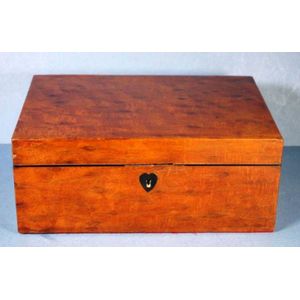Georgian Casuarina Document Box with Ebony Escutcheon
Large late Georgian casuarina document box, with ebony escutcheon, circa 1820, 35 cm x 24.5 cm, 145 cm high
You must be a subscriber, and be logged in to view price and dealer details.
Subscribe Now to view actual auction price for this item
When you subscribe, you have the option of setting the currency in which to display prices to $Au, $US, $NZ or Stg.
This item has been sold, and the description, image and price are for reference purposes only.
- Georgian - As an English stylistic period, Georgian is usually taken to cover the period from George I (1714) to the Regency of Prince George (1811-20), although the period from 1800 to 1830 is sometimes designated as the Regency period. During the Georgian period the great English cabinetmakers and designers such as Chippendale, Hepplewhite, Adam Sheraton etc., were all active.
Therefore there isn't a single 'Georgian style' as such and to say something is 'Georgian', usually means it was made between 1714 and 1830. This assumes we discount George V and George VI, both being from the 20th century.
The styles popular at the time of each reign were:
George I (1714-1727) saw out the last years of the Baroque period.
George II (1727-1760) reigned during the Rococo period.
George III (1760-1820) saw the last gasp of the Rococo, all of the early Neo-Classic 'Adam style' and most of the later neo-Classic 'Regency style'.
George IV (Prince Regent 1820-1830)encompassed the last of the 'Regency' style.
William IV's reign (1830-1837) was something of a no man's land (stylistically) and he wasn't a 'George' anyway. He covered the last glimmerings of 'Regency' and the start of the 'Victorian' style. - Circa - A Latin term meaning 'about', often used in the antique trade to give an approximate date for the piece, usually considered to be five years on either side of the circa year. Thus, circa 1900 means the piece was made about 1900, probably between 1895 and 1905. The expression is sometimes abbreviated to c.1900.
- Casuarina - Casuarina, is also known as beefwood (because of its appearance) she-oak, swamp oak, river oak, forest oak and Botany Bay wood. It is a native Australian hardwood, red brown in colour with dark flecks.
- Ebony - Ebony is a close grained timber, black in colour. It has a fine texture which can be polished to a high gloss, making it suitable for venereering, inlay and stringing and its use as solid timber is resticted to small decorative items and ornamental decoration, such as chess pieces and musical instrument parts. The term "ebonised" means "faux ebony", timber that has been darkened during the polishing process to resemble ebony.
This item has been included into following indexes:
- boxes, function
- boxes, material or decoration - Australian casuarina wood boxes 19
Visually similar items

Early 19th century tea caddy, 23 x 12 cm
Sold by
in
for
You can display prices in $Au, $US, $NZ or Stg.

Georgian rosewood tea caddy, width 17.5 cm, diameter 10 cm approx
Sold by
in
for
You can display prices in $Au, $US, $NZ or Stg.

Late Georgian flame mahogany tea caddy, with 2 lidded compartments and ebony escutcheon, 20.5 cm wide, 16 cm high, 13 cm deep
Sold by
in
for
You can display prices in $Au, $US, $NZ or Stg.

Georgian rectangular casuarina tea caddy, twin lidded inlaid interior with ivory knobs
Sold by
in
for
You can display prices in $Au, $US, $NZ or Stg.
